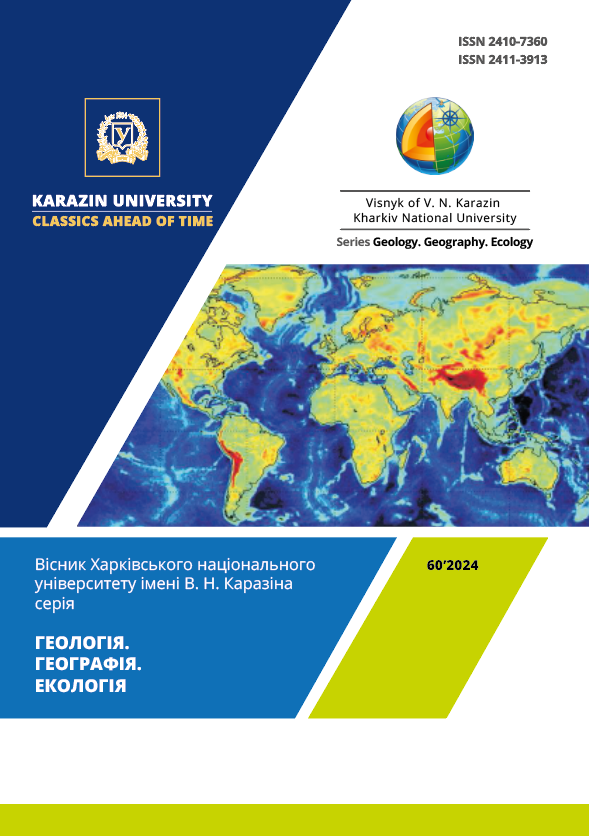Ecological problems of the plant cover of the northeastern slope of Great Caucasus (within Azerbaijan)
Abstract
Highlight the purpose. Plant cover of our republic, especially forest ecosystems, has lost its original state as a result of the influence of natural and anthropogenic factors. The study of the impact of these factors on biodiversity has been the focus of many experts. The settlement of the studied area since ancient times and the good development of agriculture have caused the degradation and erosion of the forest cover that covers large areas, as well as the vegetation that replaces each other in the altitude zones here. For this reason, the issues of protection and protection of vegetation are distinguished by their relevance. The main goal of our research is to protect the vegetation of forests that have changed their initial state.
Objectives. Mountain geosystems of the northeastern slope of the Greater Caucasus are bordered by the Russian Federation to the north, northwest, and west, the Samur-Devachi plain to the east, and the watershed line of the Greater Caucasus Range and Atachay to the south and southeast.
Methods. Field studies were organized to solve the issues raised during the research period. Short-term visual observations of the existing geoecological conditions were carried out, from topographic maps and other maps (landscape, vegetation, etc.) of various scales, as well as from 1:25000 scale aerial and space images in the fund of the Institute of Ecology of MAKA, “Google” and “Bing” space images with a resolution of 1 meter in the funds, taken in the visible zone of the spectrum, obtained from various satellites in 2020-2023 and based on the application of SASPlanet, ArcGIS processing programs were used. With the help of these materials, the vegetation degradation and erosion processes of the research area were studied.
Results. The northeast part of the Great Caucasus differs from the other mountainous regions for its appropriation features. For a long time appropriation of the investigated zone by the various farming areas caused a serious change in the natural geosystems. Thus, the zones where a hypsometric height of 200-500 m are mainly replaced by agro-complexes, the parts within 500-1800 m turned into a life and rest objects together with the arable and pastures, an irregular use from the summer pastures in cattle-breeding in the zones higher than 1800 m was completed by exposing of the plant cover to transformation. During assimilation, activation of ecological problems like decreased plant productivity, intensification of the erosion process, acceleration of degradation, and so on activates a problem of rational use. Defining importance, sensitiveness of plant cover, and rational use ways as protection, refusal of usage, extensive use of protection, development, extensive use, improvement, and development were determined.
Downloads
References
Amanova, S. (2023). Basic construction-ecological norms in urban systems and ecogeographic consequences of sustainable development of urban areas (in Sabirabad city representation). Journal of Geology, Geography and Geoecology, 32(3), 441-449. https://doi.org/https://doi.org/10.15421/112339
Babayev M.P., Gurbanov E., Hasanov V. (2010). Land degradation and protection in Azerbaijan. Baku: Elm, 215
Bruns, D. (2003). Was Kann Landschaftplanung leisten Alte und neue funktionen der land. In: Naturschutz und Landschaftsplanung (4), 114-118. [in German]
Fiese, K.I., Hachmann, R., Wolter, F. (2003). Content Management systeme in der landschaftsplanung. Crop, 419-426. [in German]
Garibov Y.E. (2012). Optimization of natural landscapes of the Republic of Azerbaijan. Baku, AzTU printing house, 216.
Goychayl Sh.Y. (2004). Problems of geography and geographic ecology, Baku: Ulu, 268.
Hokema, D. (2009). Die Landschaft der Regionalentwicklung: Wie flexibel ist der Landschaftsbegriff? In: Raumforschung und Raumordnung. 67 (3), 239-249. [in German]
Hajiyeva A.Z. (2016). Anthropogenic transformation of natural landscapes in the south-eastern slope of greater Caucasus (based on study of pasture-hayfield landscapes). "Geography and natural resources" magazine of the Azerbaijan Geographical Society. Baku. 2(4), 32-37.
Hajiyeva, G.N. (2017). Ecogeographical problems caused by the appropriating of territories located at a hypso-metric altitude of 200-500 m of the north-eastern slopes of the Greater Caucasus (within Azerbaijan), Moscow Re-gional State University “Natural science” (3), 74-81 [in Azerbaijan]
Hajiyeva G.N., Hajiyeva A.Z., Jafarova F.M. (2023). Ecological problems associated with land cover in the Great Caucasus and important aspects for efficient use. Universidad & Sociedad. Revista multidisciplinar de la Univer-sidad de Cienfuegos. 15, 1, 277-284.
Han, J., Mammadov, Z., Kim, M., Mammadov, E., Lee, S., Park, J., Mammadov, G., Elovsat, G., & Ro, H.-M.(2021). Spatial distribution of salinity and heavy metals in surface soils on the Mugan Plain, the Republic of Azerbaijan. Environmental Monitoring and Assessment, 193(2), 95. https://doi.org/10.1007/s10661-021-08877-7
Hasan, S. S., Zhen, L., Miah, Md. G., Ahamed, T., & Samie, A. (2020). Impact of land use change on ecosystem ser-vices: A review. Environmental Development, 34, 527. https://doi.org/10.1016/j.envdev.2020.100527
Jafarova, F.M. (2015). Economic and geographical peculiarities of territorial organization of livestock in the Azerbaijani, part of the Greater Caucasus / İnternational Journal of Humanities and Social Science. 5, 1. USA. Center for Promoting İdeas, 220-222
Judith, A. (2008). Landscape planning: practical techniques for the home garden.
National Atlas of Azerbaijan. Baku, 2014.
Mammadov, R.M. (2016). Landscape planning: essence and application. “Science”, 458
Mammadov, Q.Sh., Khalilov, M.Y. (2002). Forests of Azerbaijan. Baku. (in Azerbaijan). p.225
Mammadov, Q.Sh., Khalilov, M.Y. (2004). Ecological and environment p. 854
Paletto, A., & Favargiotti, S. (2021). Ecosystem Services: The Key to Human Well-Being. Forests, 12(4). https://doi.org/10.3390/f12040480
Salikhov, T.K., Sapiev, E., & Salikhova, K.S. (2018). Studying the soil cover of the Zhanakushky rural districts in West Kazakhstan region on the basis of the application of GIS-technologies. NNC RK Bulletin, 1. https://journals.nnc.kz/jour/article/view/84
The State Program on effective use of summer and winter pastures and hayfields and prevention of desertification in the Republic of Azerbaijan. (2004) Baku: May 22.
Turner, T. (2004). Landscape planning and environmental impact design. routledge. https://doi.org/10.4324/9780203214534
Von Haaren, C., Hoppenstedt, A., & Scholles, F. (2000). Landschaftsplanung und Strategische Umweltpruefung (SUP). UVP-REPORT, 14(1). https://trid.trb.org/view/948753

This work is licensed under a Creative Commons Attribution 4.0 International License.





